Published:
Author: Antonio Maria Guerra
Piadina

Unleavened flatbread is a type of food of very ancient origins. Over the millennia, it has evolved in many forms: Piadina is one of them. Let’s find out the fascinating history of this delicacy, the secrets of its preparation, and many interesting curiosities, with the precious help of the Consortium of its most traditional producers.

The history of Piadina.
It’s almost impossible to determine the date of birth of ‘Piadina’: we know for sure that it’s the result of the evolution of ‘unleavened bread’ (‘azzimo’ *1), whose origins are lost in time (*2). This could explain why specialties similar to it, sharing the same ancestor, are part of the culinary traditions of many Mediterranean, African and Asian countries (*3).
CLASSICAL PERIOD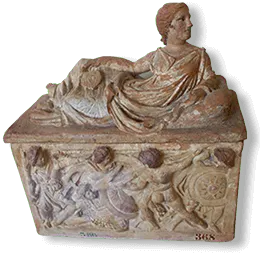 The first evidence of the preparation of unleavened flatbreads (the ancestors of Piadina) in the Italian peninsula, dates back to the Etruscan period: as early as the 10th century BC, this people used to cook circular doughs made with water and cereal flours. A tradition later adopted by the Romans (*4), who particularly appreciated the great practicality of this food: it was, in fact, an excellent alternative to bread, quick to cook, and therefore excellent for feeding their legions. It was also widely used in religious ceremonies and patrician banquets (*5).
The first evidence of the preparation of unleavened flatbreads (the ancestors of Piadina) in the Italian peninsula, dates back to the Etruscan period: as early as the 10th century BC, this people used to cook circular doughs made with water and cereal flours. A tradition later adopted by the Romans (*4), who particularly appreciated the great practicality of this food: it was, in fact, an excellent alternative to bread, quick to cook, and therefore excellent for feeding their legions. It was also widely used in religious ceremonies and patrician banquets (*5).
Read more
MIDDLE AGES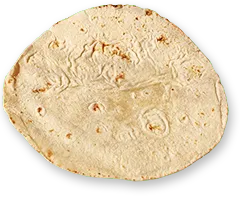 During the Middle Ages, the consumption of these flatbreads was widespread in many regions (*6) and especially in the area corresponding to present-day Romagna. They soon became the food par excellence of the poorest people, used when bread, for various reasons, started running low (*7). In times of famine their main ingredient, wheat flour (*8), could be added (or replaced) with cheaper cereal flours (*9).
During the Middle Ages, the consumption of these flatbreads was widespread in many regions (*6) and especially in the area corresponding to present-day Romagna. They soon became the food par excellence of the poorest people, used when bread, for various reasons, started running low (*7). In times of famine their main ingredient, wheat flour (*8), could be added (or replaced) with cheaper cereal flours (*9).
The first written mention of the word ‘Piada’ dates back to the second half of the fourteenth century and can be found in the ‘Descriptio Romandiole’ (1371), a document attributed to the papal legate Anglico de Grimoard.
MODERN AGE It was the famous poet Giovanni Pascoli, several centuries later (*10), who formalized the name of the delicacy he loved, the ‘Piada’ (*11). For a long time, the specialty remained ‘family food’, prepared by the ‘arzdore’, the housewives from Romagna, for their children and husbands. The situation changed completely after World War II, especially in the 1960s, at the time of the economic boom, when large numbers of Italian and foreign tourists started to pour onto the Adriatic beaches. It was then that the first kiosks (‘Chioschi’) opened along the roads leading to the sea: they were (and still are) the ‘temples of a Piada’, which, in the meantime, had become ‘Piadina’.
It was the famous poet Giovanni Pascoli, several centuries later (*10), who formalized the name of the delicacy he loved, the ‘Piada’ (*11). For a long time, the specialty remained ‘family food’, prepared by the ‘arzdore’, the housewives from Romagna, for their children and husbands. The situation changed completely after World War II, especially in the 1960s, at the time of the economic boom, when large numbers of Italian and foreign tourists started to pour onto the Adriatic beaches. It was then that the first kiosks (‘Chioschi’) opened along the roads leading to the sea: they were (and still are) the ‘temples of a Piada’, which, in the meantime, had become ‘Piadina’.
Notes:
*1: The Italian word ‘azzimo’ (‘unleavened’) comes from the Greek ‘ἀζύμη’, whose translation is ‘without yeast’;
*2: The Bible, for example, tells about the ‘unleavened bread’ (in Italian ‘pane azzimo’) eaten by the Jews during the Exodus from Egypt;
*3: Such as, for example, the ‘Pita’ (or ‘Pitta’), belonging to the culinary tradition of many Mediterranean countries, the Turkish ‘Yufka’, the ‘Taguella’ made by the Tuareg, etc.;
*4: The Roman poet Virgil, in the VII book of the Aeneid, makes clear reference to an ‘exiguam orbem’ which most probably was the ancestor of Piadina;
*5: Patricians, the Roman aristocrats;
*6: Such as the Ligurian ‘Farinata’, the Umbrian ‘Torta al Testo’ (or ‘Crescia’ or ‘Ciaccia’), the ‘Panigaccio’ (or ‘Panigazzo’) from Lunigiana, etc.;
*7: Bread could be in short supply not only because of famine but also because it was usually made only once a week;
* 8: More often corn;
* 9: At the time, ‘poor flours’, such as rye, barley, or spelt, were subject to lower taxation. It could happen that, in particularly difficult periods, acorn flour or even sawdust were used!
*10: That is to say in the early 1900s;
*11: It should be emphasized that the ‘Piada’ so loved by Pascoli had become a kind of food anything but poor: its taste was enriched by lard and many types of fillings;

Piadina
THE MOST TRADITIONAL PRODUCERS
This article is the result of the collaboration between WebFoodCulture and the Consorzio di Tutela e Promozione della Piadina Romagnola, organization gathering the most traditional producers of the specialty.

Romagna: the birthplace of Piadina.
Piadina has an indissoluble connection with Romagna, a region located in the northern part of the Italian peninsula.
Read more
Its name derives from ‘románia’, meaning ‘Roman territory’, and is due to the close relations that this zone continued to have with the Empire even after the Langobardic invasion (relations strengthened by the presence of a large contingent of legionaries in the city of Ravenna).

Piadina Romagnola: ingredients and preparation.
Here follows the list of the ingredients for Piadina Romagnola and the steps of its preparation:
INGREDIENTS
According to the Production Regulations of Piadina Romagnola PGI, the preparation of this specialty requires a few simple ingredients:
Read more
- Wheat flour;
- Water;
- Salt;
- Fats (lard, and / or olive oil, and / or extra virgin olive oil);
It’s also possible to use, albeit in minimal quantities, raising agents, such as:
- Corn (or wheat) starch;
- Sodium bicarbonate;
PREPARATION
Preparation is just as simple and includes the following steps:
1) Preparation of the dough: the ingredients listed above are mixed until the dough is ready.
Read more
2) Portioning: the dough is divided into portions (‘loaves’ or ‘balls’).
3) Lamination: The ‘loaves’ (or ‘balls’) are flattened (by hand or mechanically), making discs of the desired diameter and thickness.
4) Cooking: The discs are cooked on special plates at a temperature that varies between 200 and 250 degrees (centigrade).
5) Administering or cooling: Piadina is served. In case of industrial production, the specialty is cooled.
6) Packaging: the last stage of the industrial production process is packaging, after which Piadina is ready for marketing.
Piadina in video.
An interesting video, produced by the Consorzio di Tutela e Promozione della Piadina Romagnola, showing the preparation, the places and the people of this delicious specialty.

Piadina ‘Romagnola’ and ‘Riminese’.
Secondo il Disciplinare redatto dal Consorzio, la ‘Piadina Romagnola’, conosciuta anche come ‘Piada Romagnola’, si presenta in due tipologie, vale a dire: la ‘Piadina Romagnola’, preparata nell’entroterra della regione, e la Piadina Romagnola ‘alla Riminese’ (o ‘Piada Romagnola alla Riminese’), preparata nella zona costiera, che è, di fatto, una variante della prima. Si riportano di seguito le principali differenze:
PIADINA ROMAGNOLA
- Has an average diameter that ranges from 15 to 25 centimeters (therefore less than the type from Rimini).
- Has an average thickness that ranges from 4 to 8 mm (therefore higher than that of the variant from Rimini);
- Presents itself as an ivory-white disc with small amber spots (due to cooking), evenly distributed on the surface;
PIADINA ‘ALLA RIMINESE’
- Has an average diameter that ranges from 23 to 30 centimeters (therefore more than the other type).
- Has an average thickness of about 3 mm (therefore less than the other type).
- Presents itself as an ivory-white disc, this time with large spots randomly distributed on the surface.
Finally, it should be emphasized that Piadina Romagnola has a stiff and crumbly consistency, while the ‘Riminese’ variant is softer and more elastic (*1).
Note:
*1: The use of olive oil in the dough makes Piadina more stiff and crumbly, while the use of lard makes it more elastic.

Piadina Romagnola PGI, production areas.
According to the Regulations, the original Piadina Romagnola PGI must be produced in these areas:
Province of Rimini:
Bellaria-Igea Marina, Casteldelci, Cattolica, Coriano, Gemmano, Maiolo, Misano Adriatico, Mondaino, Monte Colombo, Montefiore Conca, Montegridolfo, Montescudo, Morciano di Romagna, Novafeltria, Pennabilli, Poggio Berni, Riccione, Rimini, Saludecio, San Clemente, San Giovanni in Marignano, San Leo, Sant’Agata Feltria, Santarcangelo di Romagna, Talamello, Torriana, Verucchio.
Province of Forlì-Cesena:
Sole, Cesena, Cesenatico, Civitella di Romagna, Dovadola, Forlì, Forlimpopoli, Galeata, Gambettola, Gatteo, Longiano, Meldola, Mercato Saraceno, Modigliana, Montiano, Portico e San Benedetto, Predappio, Premilcuore, Rocca San Casciano, Roncofreddo, San Mauro Pascoli, Santa Sofia, Sarsina, Savignano sul Rubicone, Sogliano al Rubicone, Tredozio, Verghereto.
Province of Ravenna:
Alfonsine, Bagnacavallo, Bagnara di Romagna,Brisighella, Casola Valsenio, Castel Bolognese, Cervia, Conselice, Cotignola, Faenza, Fusignano, Lugo, Massa Lombarda, Ravenna, Riolo Terme, Russi, Sant’Agata Sul Santerno, Solarolo. Provincia di Bologna (fino ai comuni tracciati dal corso storico del fiume Sillaro): Borgo Tossignano, Casalfiumanese, Castel del Rio, Castel Guelfo, Castel San Pietro, Dozza, Fontanelice, Imola, Mordano.
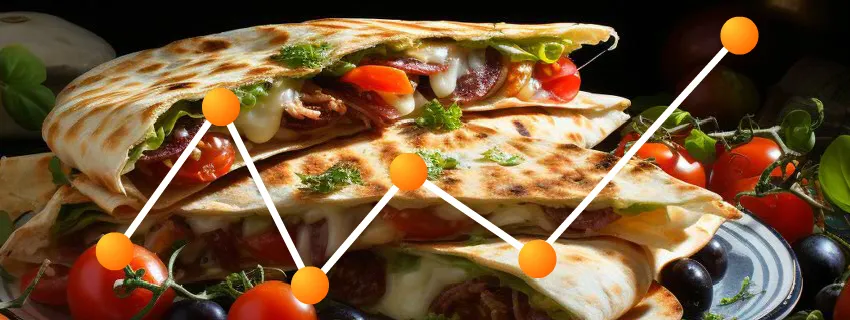
Calories and nutritional values.
Being an unleavened bread, Piadina has a fairly high specific weight: a portion of average size can easily exceed 130 grams.
Read more
The specialty contains, in order, carbohydrates, fats and proteins. Its caloric intake is quite variable: much depends on the amount of lard used in the dough. Generally, one piadina has between 360 and 420 calories (that is to say about 320/340 kcal/hg). This value grows inevitably further depending on the filling, which often (though not necessarily) consists of cured meats and cheeses.

The fillings.
If there is such a thing as an ‘anarchic’ specialty, this is without doubts Piadina: that’s because it allows great freedom when choosing the ingredients of its filling. Following the example of the most classic type, made with Prosciutto di Parma (cured ham), Squacquerone cheese, and rocket, this filling quite often consists of a combination of:
Read more
- Cured meat (eg mortadella, salami, speck, bresaola, culatello, etc.);
- Cheese (eg Stracchino, Brie, Robiola, Mozzarella, Scamorza, etc.);
- Vegetables (cooked and/or raw) like, for example, sliced tomatoes, grilled and/or sautéed peppers, etc.);
Again, there are no rules other than those dictated by the taste of those who prepare it.
Here follows some examples:
- Piadina with Parma Ham, Mozzarella di Bufala Campana DOP and Rocket;
- Piadina with Four Cheeses (Gorgonzola DOP, Fontina, Mozzarella di Bufala Campana DOP, Parmigiano Reggiano);
- Piadina with Porchetta, Pecorino Romano DOP and dried tomatoes;
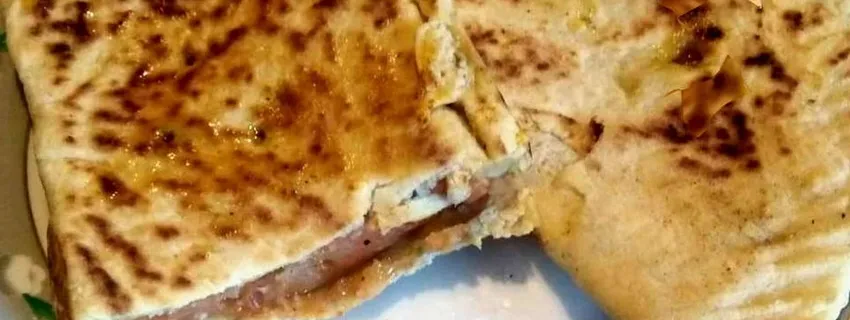
‘Crescione’ vs. Piadina.
‘Crescione’, also known as ‘Cassone’ or ‘Cascione’, is one of the most typical specialties from Romagna. A close relative of Piadina, it’s prepared with the same round pastry which, in this case, before cooking, is stuffed and folded on itself, creating a thin calzone shaped like a half-moon.
Read more
The delicacy takes its name from what was once the main ingredient of its most classic filling,the ‘Lepidium sativum’ (later vulgarized in ‘Crescione’): a herb that grew spontaneously along ditches.
Among the other fillings, let’s mention:
Tra le altre imbottiture, ricordiamo:
- Field herbs (rosole, spinach, beets);
- Mozzarella and tomato;
- Pumpkin and potatoes;
Sausages and/or cured meats can be added, optionally.

The ‘testo’.
The most traditional way to cook Piadina involves the use of the ‘Testo’, a particular type of terracotta pan (*1). The most valuable ‘Testi’ (*2) are produced still today in the Montetiffi area and are the result of the efforts of expert artisans.
Read more
After kneading a mixture of clays, they give it (by hand) the typical circular shape with a raised edge. The work ends with its seasoning and (later) its cooking in a wood oven.
Since the 1960s, ‘Testi’ are used less and less, replaced by metal plates or, in the best of cases, refractory stone surfaces.
Notes:
*1: In dialetto ‘teggia’.
*2 Il poeta Giovanni Pascoli, grande appassionato di Piadina Romagnola, chiamava queste teglie “Testi di porosa argilla”.

The origins of the word 'Piadina'.
The name ‘Piadina’, used today to indicate one of the most famous specialties from the Italian region of Romagna, derives from the dialectal words ‘Piè’, ‘Pièda’, ‘Pìda’. Many scholars think that, in turn, these come from the Greek. It was the famous Italian poet Giovanni Pascoli to ‘officialize’ the term ‘Piada’ (that later evolved in ‘Piadina’): in one of his poems, he celebrated this delicacy (much loved by him), calling it ‘il pane nazionale dei romagnoli’ (‘the national bread of Romagna’).
1918: Alfredo Panzini, in his Dictionary, defined ‘Piadina’ as “A kind of unleavened bread in a flattened and cooked on the ‘Testo’ ”.
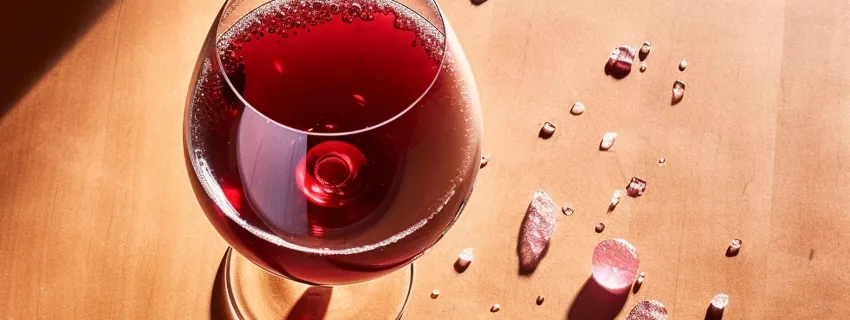
The right wine.
It’s almost useless to say that the choice of wine to accompany a Piadina varies according to its filling. Let’s say that, generally, if the Piadina is enriched with cured meat or cheese, the right choice could be red wine, better if sparkling, such as Lambrusco DOC, by which you can ‘clean the mouth’ from the greasiness of the specialty.
Read more
In the case of lighter Piadine garnished, for example, with vegetables (cooked and/or raw), the choice could fall on white wine.
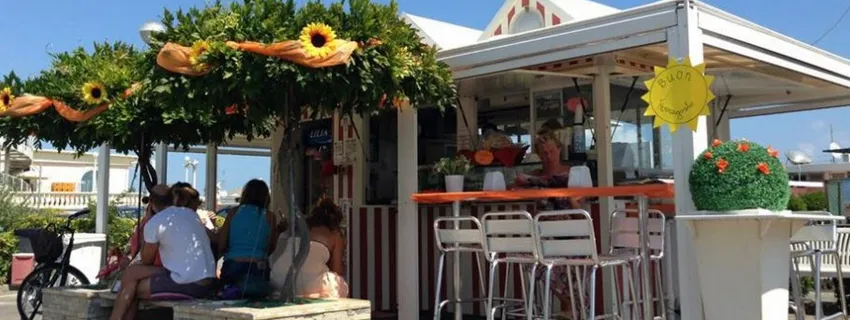
‘Chioschi’: the temples of Piadina Romagnola.
‘Chioschi’ (‘kiosks’) are the ‘temples’ of Piadina Romagnola: these small structures were built starting from the 1950s on the sides of the roads that, still today, bring the tourists to the famous beaches of the Riviera.
Read more
It was thanks to them that Piadina stopped being just ‘food for families’, usually prepared by housewives (the ‘azdore’), to become a gastronomic specialty famous all over the world. The most traditional ‘Chioschi’ are white with vertical bands, whose color is different according to the zone: for example, in Forlì and Cesena these bands are red, in Ravenna they are green.
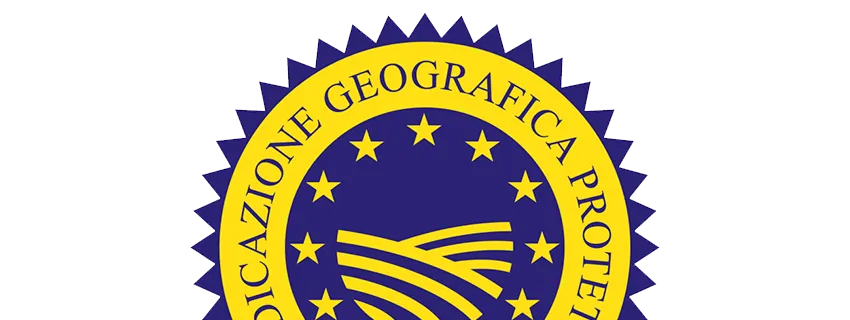
The PGI certification.
The assignment of the Protected Geographical Indication (PGI) to Piadina / Piada Romagnola (including its ‘riminese’ variant) was officialized on 4 November 2014, following the publication of the Official Journal of the European Union.
Read more
This document defined the geographical area of the specialty: an area including the provinces of Rimini, Ravenna, Forlì, Cesena and Bologna (up to the Sillaro river). The PGI certifies the quality of the product and the compliance with the rules contained in the Production Regulations drafted by the Consortium.

Consorzio di Tutela e Promozione della Piadina Romagnola: contacts.
Address: Piazza Leopoldo Tosi, 4 – 47923 Rimini
Official website: www.consorziopiadinaromagnola.it
Mail: segreteria@consorziopiadinaromagnola.it
Tel.: +39 0541 760227
Copyright information.
The images displayed in this page belong to WebFoodCulture and to the Consorzio di Tutela e Promozione della Piadina Romagnola, with the exception of:
Public Domain images
- Etruscan cinerary urn, Museo archeologico di Perugia, photo by G.dallorto (Wikipedia Link)
- Giovanni Pascoli (Wikipedia Link)
- PGI Logo (Wikipedia Link)
Creative Commons images
- Crescione romagnolo (Wikipedia Link)
